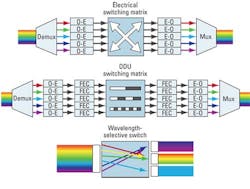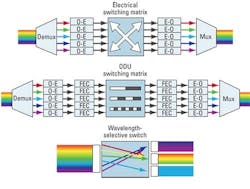By Jim Theodoras
Overview
Optical switching has evolved into three main categories. Which belongs in your network?
Optical switching has evolved through multiple successive generations, with substantial hype and hubris accompanying each transition. Nevertheless, each remains today in one form or another.
The three leading categories today would arguably be optical-electrical-optical (OEO), optical data unit (ODU), and reconfigurable optical add/drop multiplexers (ROADMs). Each of these three different classes of optical switches offers bandwidth providers different combinations of capabilities and price points that are valuable for various deployments. In fact, many bandwidth providers are looking at hybrid optical switching approaches that leverage multiple technology categories.
Intelligence at the intersections
If the Internet is referred to as the information highway, switching may be thought of as the intersections. At a major intersection, everyone waits their turn until a light signals which lanes of traffic may pass. The lights are not necessarily timed evenly. Green lights at major thoroughfares may last longer than those for intersecting side lanes. In some cases, bypasses are constructed to allow pass-through traffic to keep moving and avoid the busiest intersections.
Information switches work similarly. “Switching” is a generic term typically used to represent the sorting of information that is ingressing into a network node and distributed to the appropriate egress path. The earliest information switches—rotary phone switches—were just electrical contacts spinning on motor shafts. These grew to become rows of chassis filled with switches on blades. Meanwhile, the transport media gradually transitioned from copper cables to fiber optics.
WDM drives innovation
WDM brought big changes to optical switching. Legacy electrical switching technologies were unable to switch WDM signals on optical fibers.
WDM systems merge differing wavelengths onto a single fiber using a combiner, sometimes called a “multiplexer,” and then separate out the wavelengths again using a splitter, sometimes called a “demultiplexer.” Because early optical switches were wavelength-agnostic, signals needed to be split out, switched, and then recombined again. The problem here is the potential for “wavelength blocking”—when a signal is separated and switched to a new wavelength, it can clash with the wavelength of the combiner channel and be blocked from successful delivery.
As communication systems evolved, so did the type of information being transported and switched. The dominant form of WDM traffic carried over fiber optics became data packets of variable size aggregated and encapsulated into a session, as opposed to fixed-sized voice calls tightly interwoven into a synchronous stream.
Confronting these challenges triggered a series of optical-switching innovations and provided the impetus for the technological shifts that have resulted in the three major categories of optical switches today: OEOs, ODUs, and ROADMs.
OEOs
Optical-electrical-optical switching is a broad category encompassing a wide range of product sets, depending upon the type of information being switched, and includes synchronous ADMs, cell-based ATM switches, and core IP packet routers, to name just a few. Though marketing lingo may sometimes be used to spruce up a product, OEO remains OEO. For example, IP over DWDM (IPoDWDM) is merely a subset of OEO switching in which the WDM transponder is relocated to within the routing equipment to reduce the total number of cable connections required.
No matter the product or type of information being switched, all OEO switches use simple, brute force in dealing with WDM traffic. The WDM optical aggregate is split out into individual channels, each of which is then converted to an equivalent electrical signal. Once all the signals are in the electrical domain, they are passed through traditional electronic switch fabrics.
The problem here is that electrical switching fabrics can be massive—growing as fast as the square of the number of channels being switched. So, for an 80-channel, nonblocking square system, the electrical switching matrix would consist of 6,400 switches. The capital and operational investments to deploy, manage, and maintain these types of switch matrices are tremendous.
The drive to make OEO switches less cumbersome continues. For example, as planar lightwave circuit (PLC) technology has advanced, it has become possible to combine many passive optical elements on a single plate of glass. Photonic integration circuits (PICs), meanwhile, combine many of the active optical elements onto a common indium phosphide (InP) integrated circuit. Despite these efficiencies, OEO switches remain large, complex, expensive, and power-hungry.
ODUs
Optical data unit switches streamline the size of the switch planes.
When forward error correction (FEC)—a technology borrowed from other fields of communications to improve optical signal-to-noise ratio (OSNR)—was just coming on the scene, network architects working at standards bodies recognized a valuable possibility. Extra bits in the overhead could encapsulate traffic, thereby enabling node bypass and switching at a higher level of granularity. In the early days of this “digital wrapping”—now known more popularly as “ODU switching”—network architects imagined that everything from voice calls to packet streams would be encapsulated and switched in many layers of granularity. Today, their vision has become reality.
Optical data units encapsulate information streams in encoded channels standardized under ITU-T G.709. Multiple levels of encoding and switching are possible. While traffic streams still must be converted to the electrical domain, as with OEO switches, ODUs enable switching at a higher level immediately after the conversion. This enables much smaller, simpler switch matrices by using fewer higher-granularity switches for bypass.
However, there is an Achilles’ heel for ODU optical switching. If even a single packet of a given encapsulated stream is needed at a drop node, then that entire stream must be sent to the main switch and broken down into its constituents. But how does the switch determine which traffic bypasses a network node, and what traffic gets sent to the main switch? To maximize the effectiveness of node bypass with ODUs, all traffic has to be carefully packaged and layered before transmission. For example, all traffic destined for one location should optimally be encapsulated within the same container. While state-of-the-art routers and switches are fully capable of providing this function, they must be properly configured to do so.
ROADMs
ROADMs are another type of switch that seeks to leverage the advantages of node bypass while affording bandwidth providers an unmatched level of flexibility.
With ROADMs, no conversion to the electrical domain is required, thus minimizing electronics and power consumption. Information streams are switched at the wavelength level of granularity. This technique, of course, depends on prior knowledge of what is contained in the wavelength—a much steeper requirement compared to ODU switching, given that no electrical conversion has occurred. Network architects have come up with several novel approaches to solve this conundrum, ranging from manually pre-assigning each wavelength, to relaying intelligence from node to node on an optical supervisory channel, to hiding the needed information on an optical sideband to each channel.
Early ROADMs—involving hundreds of discrete optical switches, dielectric filters, and sometimes variable optical attenuators—were rats’ nests of fiber that rivaled the complexity of OEO switches. In fact, many early ROADMs comprised just a specialized subset of OEO switches. Today’s ROADMs, however, have benefited greatly from the evolution of technology and typically leverage either PLCs or wavelength-selective switches (WSS) to more tightly integrate necessary functionality, reduce ROADM complexity, and boost stability.
Today, several classes of ROADMs are in use in bandwidth providers’ networks:
- dynamic—enabling wavelengths to be switched as necessary with fluctuations in traffic requirements, as integrated optical attenuators automatically re balance channels when networks are reconfigured or new wavelengths are turned up
- colorless—enabling add/drop wavelengths to be assigned to a fixed physical port on network equip ment, thereby minimizing a bandwidth provider’s truck rolls
- directionless—enabling wavelengths to be switched not only between bypass and add/drop, but also in any network direction. State-of-the-art directionless ROADMs convey myriad benefits such as the ability to build mesh networks, to supple- ment fiber protection with path protection, and to adopt agile optical networking
A hybrid approach
In the face of relentless growth in bandwidth consumption that threatens to outpace the growth of their own core Generalized Multi-Protocol Label Switching (GMPLS) IP networks, many bandwidth providers are turning to hybrid optical switching approaches as the solution to their predicament. Hybrid network architectures combine any and all optical switching technologies in an attempt to find the best balance of features for the intended application.
Here’s one example of how multiple techniques may be combined to create a more efficient switched network:
- core OEO IP routers are scaled as rapidly as possible and are used for packet-level switching granularity
- OEOs are surrounded by ODUs that serve two functions. First, all encapsulated IP traffic that is not needed at the network node can bypass the router. Second, legacy SONET/SDH traffic can be switched around the core routers or offloaded to ADMs if needed
- ROADMs are used for switching at the wavelength level of granularity, again serving multiple purposes. First, the IP core routers may be inter- connected as a mesh, allowing packets to travel the most direct path rather than around a ring. Second, path protection is provided in addition to traditional ring protection techniques. Third, an entire wavelength may be optically amplified and/ or regenerated and passed around the ODU and IP packet switches
Although at first glance using multiple optical-switching technologies might appear to be overly complex, it actually ends up greatly simplifying the overall network, as each type of information carried is properly routed around the network and only processed when absolutely needed.
Coexistence of multiple optical switching technologies is likely to continue for some time, given that bandwidth providers’ capabilities and cost requirements in optical switching are likely to vary across their networks.
Which is best?
What optical switching technology is best continues to be a fiercely debated topic. OEOs, ODUs, and ROADMs have each taken a turn as the proposed optical switching technology to end all optical switching technologies.
ROADMs (especially multidegree varieties) were for a time regarded as the end game in optical switching. Then PICs and PLCs came along, and there was a surge of predictions that higher-density integration would favor OEO switching. Recently, ODU switching has made a comeback.
In reality, each category has its pros and cons, and identifying the optimal approach—or determining whether one of the increasingly prevalent hybrid options is appropriate—depends upon a particular bandwidth provider’s infrastructure and applications.
Jim Theodoras is director technical marketing at ADVA Optical Networking.
Links to more information
LIGHTWAVE: ROADM Economics Drive CLEC and Tier 2 Deployments
LIGHTWAVE: All-Optical Tops OEO for Metro and Regional
LIGHTWAVE: System Vendors Offer Thoughts on ROADM Components

